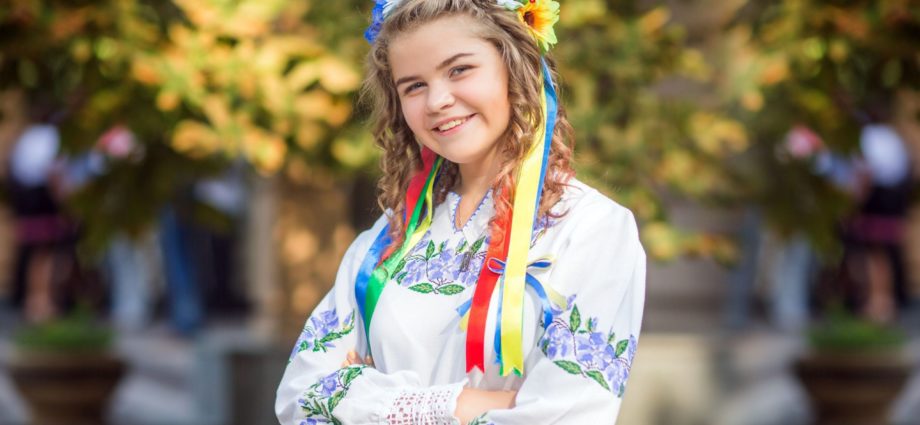
ADVERTISEMENT
Many readers may have heard of the Vynok, or flower crown, in Ukrainian culture or seen photos of them, possibly from protestors at the Stand with Ukraine rally in London.
A Vyshyvanka is an ornately embroidered dress, tunic or shirt. Embroidery is an important craft within Ukraine; different techniques exist to suit local styles with their own particular patterns and colours. Traditionally, the thread was coloured according to local formulas using bark, leaves, flowers, berries, etc. Relecting the local environment is in the colour of the embroidery.
Zoomorphic figures, geometric shapes and floral ornamentation adorn the material. Much of the embroidery is built up using cross stitch. Floral ornaments depict the beauty of nature, popular themes being oaks, grapes, poppies and lilies,
Symbolism of the Vyshyvanka
The Vyshyvanka is symbolically a talisman to protect the wearer. Embroidery was used in vulnerable places on the garment where evil spirits could potentially enter the body along the neckline, cuffs, shoulders, back and hem, any position where the body was open to danger. Embroidered shirts were given as presents to newborn babies in order to protect them from evil spirits.
Women would make it for their children stitching intricate patterns into a shirt and believed that it would turn their vyshyvankas into a lucky piece for their relatives..
Background and inspiration for designers
Ukraine’s love for embroidered shirts dates back to the ninth century BC, when Scythians, who lived in the territory, wore the clothing. Greek historian Herodotus (425 BC) described Scythians’ clothes embroidered with ornaments. The Vyshyvanka inspired some of the boho style fashions in and around 2014-16, Popular, designers took inspiraton from it, including Gautlier and Valentino, who took inspiration from patterns in the national museum.
The Vyshyvanka was traditionally crafted by women, who passed their knowledge of embroidery down the female line, many families creating their own specific design. A bride would make a Vyshyvanka for her groom…
Needlework was considered to be women’s work. Cross stitching skill was inherited from grandmothers to mothers and then to their daughters. Each family had its own recognizable symbols and patterns. Nowadays some Ukrainian villages still have women craters, who bring national ornament features and the teaching of embroidery arts to commnities.
Vyshyvanka Day
The Vyshyvanka has become a symbol of national identity
May 19 2022 is Vyshyvanka Day in Ukraine, traditionally celebrated on the third Thursday of May every year. Ukrainian communities around the world celebrate this too, plus those Ukrainians far from home.
Millions are now displaced as refugees, without sufficient clothes to wear as refugees. The Vyshyvanka takes on even more special significance for these people.
The Vyshyvanka is much more than a folk costume and is incorporated into everyday attire. It has gained in popularity especially since 2014.
Fashion designers now
The Vyshyvanka and their creative arts functions as a source of income for the war and political struggle against Putin. The Vyshyvanka literally allows input to defend the country via financial contributions.
Some well known designers, who you may have heard of.
The creations of Yulia Magdich bring a modern twist to Vyshyvanaks and feature large emboridered flowers such as pansies.. She is giving all proceeds from her current stocks to the war effort. Yulia’s grandmother was into waving and produced homespun cloth which her mother embroidered. She taught Julia different embroidery techniques and told her about the energy of embroidery, its symbolism and the power to protect the wearer.
Oksana Karavanska, another well-known Ukrainian designer, and Kateryna Levenko, both attribute worldswide interest in the garments to the 2014 revolution. Levenko has embroidered the traditional clothing since she was a schoolgirl in her native village in northeastern Ukraine where she learnt the craft from her mother. (See Genya Savilov)
Vita Kin, whose garments exhibit Ukraninan tradition with a 70s vibe, and her own embroidery style, with large flowers. Vita Kin’s designs introduced Ukraninan fashion to the Paris catwalk
Oksana Polonets, a famous deigner who dressed the president‘s wife on independence day in 2017. She started in 2003 from home, and ended up with a larger team of employees. Her wedding dresses are renowned worldwide.
In part 2 and 3 of this series, North East Bylines explores the political context of the shirts vis-a-vis national identity and resistance. We chat to a local designer in Lviv on modern ethno trends.


